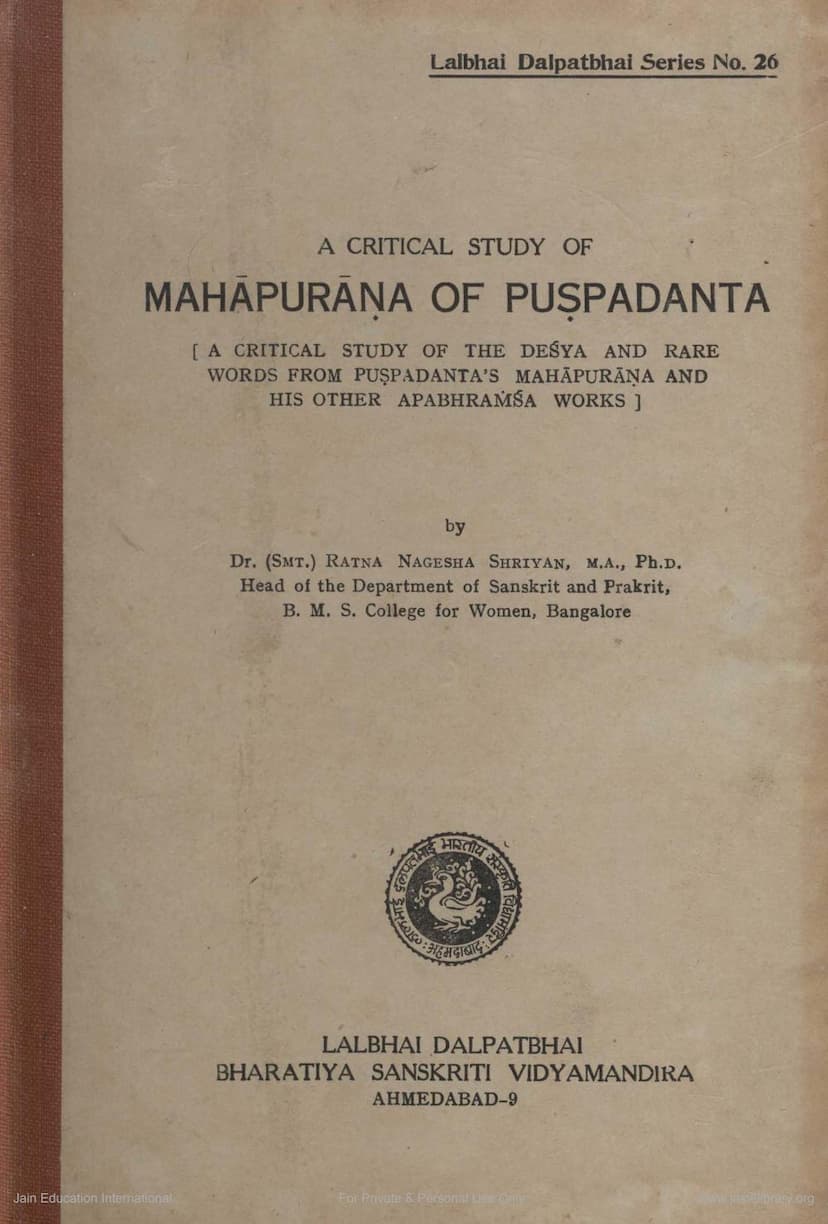Mahapurana Of Puspdanta
Added to library: September 2, 2025

Summary
Certainly! Here's a comprehensive summary of the book "A Critical Study of Mahāpurāṇa of Puṣpadanta" by Dr. Ratna Nagesha Shriyan, based on the provided pages.
Book Title: A Critical Study of Mahāpurāṇa of Puṣpadanta Author: Dr. (Smt.) Ratna Nagesha Shriyan Publisher: L. D. Indology, Ahmedabad (Lalbhai Dalpatbhai Series No. 26) Focus: A critical study of the Deśya (indigenous) and rare words found in Puṣpadanta's Mahāpurāṇa and his other Apabhraṃśa works.
I. Introduction and Purpose:
The book is a doctoral thesis approved by the University of Bombay, focusing on the significant but complex Deśya element within Middle Indo-Aryan (MIA) lexicology. The author aims to provide a critical and comparative study of over 1,000 Deśya and rare words identified in the three Apabhraṃśa works of the 9th-century poet Puṣpadanta:
- Mahāpurāṇa (MP.)
- Nāyakumāracariu (NC.)
- Jasaharacariu (JC.)
The study addresses the character, scope, and function of the Deśya element in MIA literature, particularly within Puṣpadanta's oeuvre. It seeks to clarify the meaning and usage of these words by consulting traditional Prakrit grammars and lexicons, as well as modern scholarship.
II. Methodology and Structure:
Dr. Shriyan's methodology is empirical. For each word studied, she meticulously:
- Notes the meaning provided in Sanskrit glosses found in the manuscripts.
- Collects all references of the word's occurrence in Puṣpadanta's works, and other Apabhraṃśa and Prakrit texts (utilizing available indexes).
- Consults traditional sources like Hemacandra's Deśīnāmamālā and Prakrit grammars.
- Examines modern lexicographical works and comparative studies.
- Provides counterparts in Gujarati, Marathi, Konkani, Kannada, and Telugu where applicable.
- Examines the meaning in all these contexts to arrive at its true form and meaning.
- Offers critical notes, points out errors in previous scholarship, and makes original suggestions.
The book is divided into two parts:
- Part I: Introduction: This section discusses the nature and scope of Deśya words, the basic sources used (Puspadanta's works), the plan of study, the historical development and character of Deśya vocabulary, and Puṣpadanta's specific use of this element.
- Part II: Lexical Study: This part presents the collected Deśya and rare words with detailed critical and comparative notes on their meanings and interpretations.
The study also includes:
- Appendix I: Lists Deśya and rare words exclusive to Nāyakumāracariu and Jasaharacariu.
- Appendix II: Presents rare words found in the old glosses of the works studied.
- Bibliography: A comprehensive list of consulted texts and scholarly works.
- Index: An alphabetical reference index of all discussed words.
III. Key Findings and Contributions:
- Importance of Deśya Words: The study underscores the crucial role of Deśya words in understanding Prakrit and Apabhraṃśa literature, as a significant portion of New Indo-Aryan vocabulary traces its origin to this element.
- Puspadanta's Significance: Puṣpadanta's Mahāpurāṇa is recognized as an extensive and important source, precisely dated and geographically located, making it ideal for lexical study.
- Classification of Words: The book categorizes words based on their linguistic sources, including:
- Items only derivable from Sanskrit.
- Tadbhavas with specialized or changed meanings.
- Items partly derivable from Sanskrit.
- Items found only in late Sanskrit lexicons.
- Onomatopoeic words.
- Foreign loans (Dravidian, Persian).
- Pure Deśi words.
- Character of Deśya: The introduction provides an extensive survey of ancient and modern views on the definition, character, and scope of Deśya words, highlighting the confusion and heterogeneity associated with the term.
- Hemacandra's Contribution: The study critically examines Hemacandra's Deśīnāmamālā, acknowledging its significance while also discussing criticisms from modern scholars regarding the inclusion of Tatsama and Tadbhava words.
- Puspadanta's Vocabulary: The author meticulously analyzes over 710 words from Puṣpadanta's works, comparing them with Hemacandra's lexicon and other sources. The study highlights the rich Deśya and rare vocabulary used by Puṣpadanta, indicating his proximity to spoken idioms and regional influences, particularly the likely impact of the Kannada-speaking region where he worked.
- Lexicographical Value: The work is highly valuable for students of Apabhraṃśa, Deśi words, and New Indo-Aryan languages, providing well-documented material for lexicographical studies and opening new avenues for understanding Prakrit and Apabhraṃśa texts.
- Specific Word Analysis: The second part of the book provides detailed analysis for each word, citing its occurrence, English meaning, derivation, parallels from other texts, and references from dictionaries and authorities.
IV. Overall Impression:
The book is a painstaking and systematic scholarly endeavor, praised by the General Editor, Dalsukh Malvania, for its empirical method and its contribution to understanding Apabhraṃśa, Deśi, and New Indo-Aryan languages. H. C. Bhayani, in his foreword, emphasizes its role as a foundational step for investigating the authenticity of Hemacandra's Deśīnāmamālā and a valuable resource for MIA and NIA lexicography. The author expresses deep gratitude to her mentor, Professor Dr. Harivallabh C. Bhayani, whose guidance was crucial for the completion of this work.
This summary covers the main aspects of the book, including its purpose, methodology, findings, and significance within the field of Indo-Aryan linguistics.